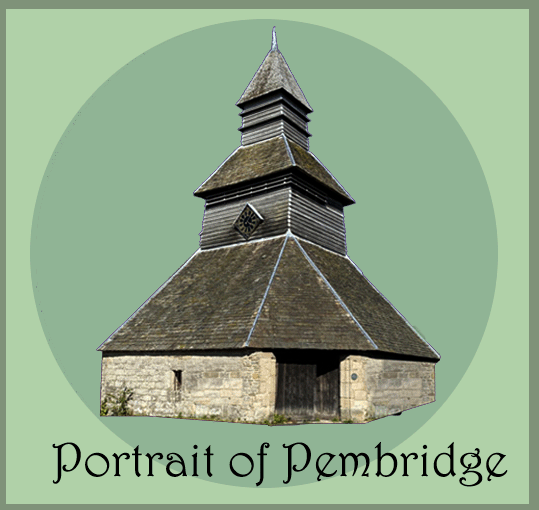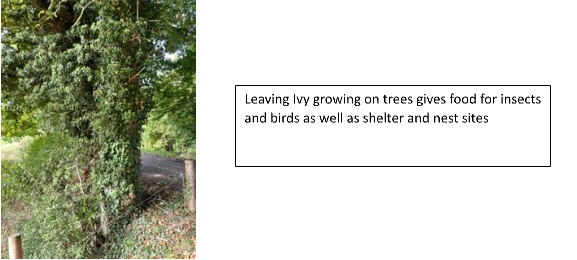The Importance of Hedges in Farmland
There are about 17 kilometres of hedges on the Leen, they are managed in many different ways. We once estimated that the farm produced over 100 tons of nuts, fruit and berries each year (Hazel and Walnuts, Chestnuts, Acorns, Hips, Haws, Elder, Blackberry, Holly, Spindle, Sycamore and Maple seeds). This is a huge resource for the wildlife of the farm.
Although there are recognisable hedges in Northern France, Austrian Alps, parts of the USA and even in the Peruvian Andes. Rural pictures from countries in Europe show few hedges with, maybe some ‘shelter belts’, woods or even lines of trees planted on either side of the road. Hedges seem to be a very British thing - Why is this?
Their history often goes back a very long way, even to Neolithic times, in some cases, where clearings in the forest had some sort of boundary to prevent stock wandering away. These will be the oldest hedges deriving literally from the original ‘wildwood’ and containing the richest diversity of shrubs, trees, plants, insects and fungi. Later, as the population increased these boundaries became stable as areas were being put to different uses and the concept of ‘fields’ arrived.
There are signs though the Bronze and Iron age and into Roman times that field boundaries became very much more formalised with square or oblong shapes, boundaries of walls, ditches or banks- many of which may have eventually had shrubs/trees growing along them, being remnants of the ‘wildwood’, planted or self-seeded.
After the Romans left, the Anglo Saxons took over and started/ continued to carve ‘estates’ into the countryside often with features that left their stamp right through the previous layouts. Such as the Rowe ditch that runs through the middle of our farm:
The Rowe Ditch c. 700 AD
With the Norman conquest, many of these estates were re-distributed and changed over to the ‘manorial system’ with large ‘Open fields’ run on a community system with strips often owned and managed by different people. Fragments of this system can still be seen in and around Pembridge. Often the estate and parish boundaries would be left, as would hedges along roads, rivers and streams and around ‘common’ land. These are very old hedges that, to this day, have a massive diversity.
Here the history of Britain’s fields starts to diverge from Europe, in that theirs largely stayed on the ‘Open Field system’ and we started to ‘Enclose’ our land. Some estate owners built massive houses and beautified their estates and rented out land to tenants. During the 17th / 18th and into the 19th centuries, when they couldn’t do it by agreement, they used parliament to pass Enclosure Acts which eventually related to just over a fifth of the area of England, amounting to some 6.8 million acres. Many of the hedges, planted at the time would be planted in straight lines with Hawthorn or Blackthorn used as their basic plant material.
Coming to the Nineteenth century hedges on arable land were often planted so that fields had parallel edges for a steam engine to be parked on either side with a plough passing between them. This happened at The Leen in the 1850’s.
Into the latter half of the twentieth century, serious mechanisation and government policy led to maybe half of the 1,000,000 kilometres of 1945 hedges being ripped up to make more efficient use of our land.
Finally, in the 1990’s, the hedges were protected and have indeed been slowly increasing in length by use of such things as Countryside Stewardship to inspire planting.
This potted history shows the wide diversity of origins of our hedges and begins to show why they vary so much. When taken with all the different management styles that variety is so important for wildlife.
The oldest hedges are often on a bank, being worn away on the lower side. They may contain woodland tree species such as Sessile Oak, Small leaved Lime, Field or Wych Elm, Maple, Holly, Hazel, Rowan or even occasionally a Yew. When this type of hedge, as it often has, a road running beside it, the other side of the road may have an entirely different assemblage perhaps dominated by Hawthorn, Blackthorn, dogwood, Ash with possibly a few apples, Gooseberries or Walnuts thrown in (germinated from seed left by previous passers-by) This type of hedge may be several hundred years younger.
In the 1970’s it was worked out that it was quite possible to ‘guesstimate’ reasonably accurately the age of the hedge by counting the number of woody species in a 30-metre length of hedge and multiplying by 100 –so 7 spp= 700years old. This is a guide only and could be disputed because 1. A new beech hedge has been known to be planted and within 10 years 4 other species were in it (Holly, Ash, Hazel, Cherry) 2. Many newly planted hedges have 10 or more different species.
These hedges may have young, Veteran or Ancient trees growing in them. In the past Landlords retained the Oak and Elm for its valuable timber and woe betide any tenant that nailed or stapled any fence to those trees! Tenants were permitted to Coppice (cut regularly, near the ground), Pollard (cut regularly 8/10 feet above the ground) or Shred (cut annually for fodder) trees such as Willow, Poplar, Elm, Ash or Chestnut. Tenants and smallholders would often plant fruit trees (particularly Damsons) in the hedges. Fragments of this diversity still remain in our hedges today.
A century ago most farms were mixed, so they had to contain stock, mostly sheep and cattle. Hedges were well maintained, being trimmed by hand between Haymaking and Harvest with incredibly sharp hedging hooks cutting the soft summer growth- this was the traditional time for hedge cutting. The older generation of farmers used to measure with their sticks- a yard each way!
Every 10-15 years they were just ‘sided up’ for 4 or 5 years and then ‘layed’ or ‘pleached’ to rejuvenate the hedge plants and create a more stockproof fence (so a Blackbird could not fly through it- as my Grandfather used to say).
What are we looking for in our hedges these days?
-Wide diversity of species of trees, shrubs, plants, insects and fungi and mycorrhiza.
- Shelter for all –Nesting, burrows etc
- Food for all - even part of the diet for some of the year.
- Ability for all spp to move, especially for food and between habitats
- somewhere to reproduce, lay eggs, bring up young
- useful to the farmer, boundary, fence, shelter, wood products
- easy to maintain
- source of fodder, minerals
- beneficial insects give biological disease control
- uncompacted soil absorbs and holds water
- Sequesters Carbon both above and below ground.
How can we as farmers improve the situation?
Maintenance of an adjacent ditch, even if only seasonally wet, massively improves all of the above.
Leave the hedge trimming until the end of the season(February)
Only cut one side alternately each year
Cut every 2 years.
Care for existing Veteran and Ancient trees in hedges.
Coppice some.
Let them get taller and wider
Allow a margin or rough edge to the field
Keep manure, fertiliser and spray drift away from hedges.
Prevent overgrazing by stock, especially sheep.
Farmers have a great opportunity to link up the many wildlife areas we have and improve the natural history of the countryside as well as their own businesses- and in most cases the trees and bushes are already planted!
On average, in Herefordshire, there are 40 metres of hedge per Hectare of farm. An average farm might be 200 hectares with 8 kilometres of hedge. It could have trees in it say 50 metres apart -160 trees.
If the hedge was cut say 1.2 metres wider each side and 2 metres higher than the traditional cut (1mX1m) then the volume of the hedge could be 10 times greater!
This would sequester a lot more Carbon and what would it do for the wildlife?
Further reading:
Pollard E, Hooper,MD., Moore NW., Hedges. The New Naturalist, Collins 1974
Wright John. A Natural History of the Hedgerow 2017 Profile Books









